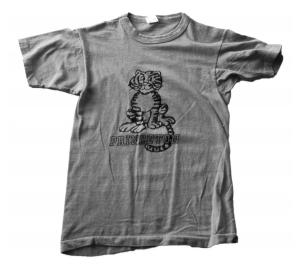For as long as I can remember, what people wear when they fly has fascinated me. My mother was a flight attendant, and whenever I saw her in uniform (pale blue blouse, dark navy slacks and vest, blazer with two silver stripes on the sleeves, wings and American flag pin on the breast) I knew she was going to leave.
Whenever my family flew anywhere together, we had to dress very formally, like old-fashioned air travelers. Even if we were just going on vacation, I had to wear a dress and close-toed shoes, never a tank-top or flip-flops. Because my family was using the airline’s employee passes to travel, we were considered representatives of the airline and had to dress accordingly.
Such wardrobe restrictions have eased since 2010, when the airline amended its pass rider policy. Now that I have a greater degree of choice in my airport wardrobe, I naturally think a lot more about what to wear, like a former uniform-wearing student who suddenly gets to choose what to put on before school each day.
Since flying as a pass rider necessitates large amounts of time spent in the airport to succeed in getting a seat on a plane, I’ve had plenty of experience observing travelers’ attire. One huge travel trend that I began to notice in particular once I started college is that of wearing school apparel. At Chicago O’Hare, my hometown airport, highly represented universities include Notre Dame, Indiana, Iowa, Michigan…Midwestern schools for a Midwestern hub. It’s not just a students’ trend, either. I’ve seen everything from infants in spirit onesies to senior citizens in logo-stamped sweaters.
Ever since flying lost its luxury status, travelers have generally relaxed their style from formal and professional to casual and comfortable—college gear is thus an easy choice. With the exception of business travelers, most people I see in airports are dressed in an exceptionally laid-back manner, one that can seem incongruous with the magnitude of the voyage that they’re about to undertake. When we board a flying vessel to journey hundreds of miles across the earth, should we look any different from traveling by an everyday car, bus, train, etc.?
Perhaps not. After all, the decline in the prestige of air travel corresponded to the industry’s transformation from a rare privilege only affordable for the few to a service available to the many. According to the International Air Travel Association, on average, over 8 million people currently fly per day.
Flying may be more common now, but I believe that it remains distinct from travel by other means. Today’s unprecedented volume of air travel has made the world a much smaller place; it has made airports the portals through which millions pass each year.
None of this entirely explains why the many people who wear college gear to the airport choose to do so. I believe the reason stems from the idea that stepping into an airport is like stepping into a limbo, like standing on the foyer of the world. From here, you can go anywhere. An airport is a separate dimension in itself, where all different times and spaces converge at once. It is not so much a place as an anti-place, as a potential-place, an anonymous place perched upon the edge of the earth.
When people enter such a void and unmoor themselves from the fixed points of their lives, what they decide to carry with them from place to place can be what anchors them to their origins, or what helps them to plant a new stake. Cast adrift into this vast, undefined dimension of voyagers, they have only their bodies—their arms, hands and backs—to bear their belongings. In the airport, the base of departure from the familiar, the clothes people wear are one of the only ways to show where they come from. No matter what new destination they depart for, they can choose to bring their home base with them, in the letters, logos and places they brand themselves with. Like the luggage tags bearing their home addresses that they attach to their checked bags before relinquishing them to the churning underbelly of the airport, their attire can ground them, remind them of who they truly are in a space so fluid.
One day at the airport this summer, I sat down at a gate in Chicago and immediately spotted a stranger wearing a familiar green and grey Rocky jacket. I hadn’t expected to encounter any Princeton students on my trip from Chicago to Washington, D.C., where my family was heading to move my triplet sister back into Georgetown University. I had never seen the Rocky boy before, and he likely didn’t recognize me as a fellow student, because before leaving for O’Hare that morning, I hadn’t put on my Princeton baseball cap or my Princeton sweatpants. I wore not one of my Princeton t-shirts or Princeton sweatshirts.
My pass rider rules didn’t prevent me from wearing any of these items. My reasons were more mundane—it was too hot out for any sweats, I didn’t need my hat, nearly all of my Princeton t-shirts were spending the summer in Princeton storage. But even during the school year, my go-to airport apparel doesn’t include a Princeton shirt.
My favorite thing to wear—my “lucky travel shirt”—is a light grey long-sleeved tee that I bought during a visit to the school where my sister wanted to spend the next four years of her life. GEORGETOWN UNIVERSITY, the shirt reads in navy letters, above a drawing of the scowling bulldog mascot.
I wasn’t wearing the shirt that day—I didn’t need to, because my sister was right there by my side. I like to wear it when I am traveling alone, at risk of becoming lost in the airport’s limbo. My relationship with my triplet sister has always been a huge part of my identity, and wearing a symbol of her can calm me when I’m not always sure of where I’m going.
